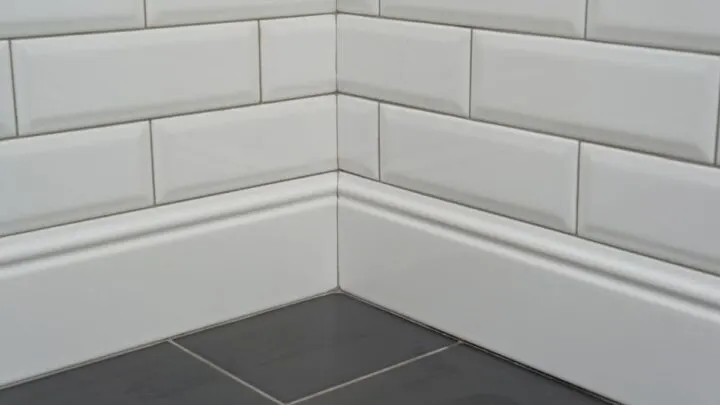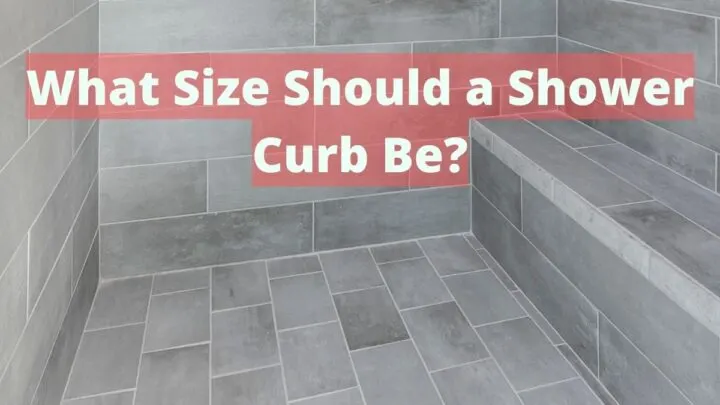Most people don’t think about the height of their shower curb until they trip over it. If you have been tripped up by a too-high shower curb, you’re not alone.
Making a mistake when choosing the size of your shower curb can be really frustrating and expensive. If you choose too small, you’ll have to tear out the tile and start over.
If you choose too large, you’ll have wasted money on materials and installation.
The height of a shower curb should be at least 2 inches above the top of the drain, and the minimum length needs to be 36 inches, according to U.S. building codes. The length can go up to 60 inches if needed.
When it comes to remodeling your bathroom, one of the most important decisions you will make is what size your shower curb should be.
This may seem like a simple question, but there are many factors to consider when making this decision.
In this article, we will discuss everything you need to know about shower curbs so that you can make the right choice for your home.
What Is a Shower Curb?
A shower curb is a raised platform that is placed at the edge of a shower.
It serves several purposes, including providing a protective barrier to prevent water from leaking out of the shower and onto the floor, as well as providing a sturdy surface for standing or resting while taking a shower.
Typically made from materials like stone or ceramic, the curb helps create a clean and functional space in the bathroom.
Additionally, since it extends over the edges of the shower’s tile or other wall covering, it adds an additional visual interest to this area.
Whether you’re looking to update your existing shower or install a new one, choosing a stylish and functional curb is essential for creating a relaxing experience in your daily shower routine.
What Size Should a Shower Curb Be?
When it comes to designing or renovating a bathroom, one of the most important considerations is often the size and shape of the shower.
Whereas many modern showers are simply tiled walls that extend straight out from the wall of the bathroom, there can also be a curb or ledge around the edge to provide support for a shower curtain or door.
So, what is the ideal size for a shower curb?
The best choice will depend on several factors, including personal preference, style preferences, and any particular building codes in your area.
According to the U.S building code, the minimum length for a shower curb is 36 inches, but it can be as much as 60 inches.
The height of the shower curb should be at least 2 inches above the top of the drain, meaning that the average shower curb is between four and six inches tall.
These dimensions are designed to allow for safe entry and exit from the shower, even for people with limited mobility.
Thus, as an important component of any bathroom design project, it is crucial that homeowners take these guidelines into consideration when planning their shower layouts.
Ultimately, the appropriate size for a shower curb will depend on several key factors, including user accessibility needs, anticipated use of the space, and safety regulations.

What Slope Should a Shower Curb Be?
Another important consideration is the slope of the shower curb.
The ideal slope is between ½ inch and ¼ inch per foot, so that water will drain properly while still providing enough support for people to sit or stand on without slipping.
If you have a particularly small bathroom, you may want to consider a shallower slope so that there is more space inside the shower itself.
Is It Necessary for Shower Curbs to Be waterproof?
In today’s modern bathroom, it is not uncommon to find shower curbs with waterproof features.
These features are typically constructed of stainless steel or aluminum materials and fitted with specialized sealants to keep the water from seeping down into the floor.
While these measures are certainly useful for preventing leaks in damp environments, there is debate about whether or not shower curbs really need to be waterproof.
On the one hand, it is easy to see why waterproof shower curbs might seem like a good idea.
Many bathrooms are prone to moisture buildup, which can wreak havoc on structural materials like wood and drywall over time.
If water can seep down into the base of a shower cubicle and accumulate there, then this may lead to water damage and rot in surrounding areas.
Therefore, it can seem like having a shower curb that is completely waterproof would be an effective way to prevent such damage from occurring.
On the other hand, however, some argue that waterproof features are not always necessary.
It is true that the average home will encounter quite a bit of moisture in the air due to cooking and cleaning tasks, as well as normal humidity levels outside.
However, if you properly ventilate your bathroom using windows and fans designed to remove moisture from the air, then this should be sufficient to keep the area dry most of the time.
In addition, many shower curbs are now made with materials that are naturally resistant to water damage, such as fiberglass and acrylic.
Therefore, if you choose a high-quality shower cubicle that is properly ventilated, you may not need to worry about waterproofing it at all.
How Can You Build a Shower Curb?
If you are planning to build a shower curb in your bathroom, there are a few things you will need to take into consideration.
First, you will need to decide on the dimensions of the shower curb. This will help you determine the size and shape that will be most appropriate for your space.
It is generally recommended to use one or two smooth, straight boards for your shower curb. This can create a more aesthetically pleasing look and reduce any exposed screw or nail heads.
Next, you will need to choose a material for the shower curb. Some common choices include concrete, tile, stone, and brick.
Each of these materials has its own advantages and disadvantages, so it is important to do some research to find out which one would be best for your needs.
Once you have selected your materials, the next step is to decide where to position your curb along the bottom edge of your shower wall.
In general, it’s best to have at least 1-2 inches of space between the tip of the curb and where the floor meets the bottom edge of the wall.
If possible, try to position your shower drain so that it sits directly over the center point on top of the faceplate on the floor surface below.
Once these initial steps are complete, you can begin constructing your curb by securing your boards in place with nails or screws.
Be sure to leave a gap between boards as needed so that water does not spill over too quickly into any adjoining areas like a bathroom floor or hallway.
After your boards are in place, it’s time to add mortar or grout around the edges of each board to create a seamless, waterproof seal.
You can do this by mixing together the appropriate amount of mortar or grout according to the manufacturer’s instructions and then using a trowel to apply it evenly along all seams between boards.
Once again, be sure to use a level during this process so that your shower curb remains even on all sides.
After allowing ample time for the mortar or grout to dry completely, your new shower curb is ready for use.
Summing Up How Tall Shower Curbs Need to Be
Shower curbs, which help protect the rest of your bathroom from the water inside the shower, are a great addition to any bathroom. Typically, they’re around 4-6 inches in height, and have to be at least 36 inches long.
You can put in your own shower curb if you want to, just make sure you measure accurately beforehand!


